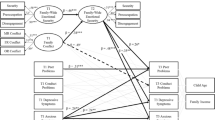Abstract
Interviews were conducted with parents of 136 female and 45 male adolescents categorized into risk groups for the later development of an eating disorder. The family and school concomitants of risk status in females were demonstrated to be different from that in males. Risk group female adolescents rated family cohesion, parent-adolescent communication processes, and overall family satisfaction more negatively than the comparison group. Mothers of moderate risk group females reported lower family cohesion than the comparison group; there were no group differences for adolescent females in fathers' ratings of family measures. However, no group differences were found on any of the family measures between male risk and comparison males. For both females and males, there were no significant group differences in family history of eating and mood disorders, or alcohol dependence. Teacher ratings indicated relatively greater internalizing tendencies in the high-risk female group.
Similar content being viewed by others
References
Achenbach, T. M. (1991).Manual for the Teacher's Report Form and 1991 Profile. University of Vermont Department of Psychiatry, Burlington, VT.
Biederman, J., Rivinus, T., Kemper, K., Hamilton, D., MacFadyen, J., and Harmatz, J. (1985). Depressive disorders in relatives of anorexia nervosa patients with and without a current episode of nonbipolar major depression.Am. J. Psychiat. 142: 1495–1496.
Bulik, C. M. (1987). Drug and alcohol abuse by bulimic women and their families.Am. J. Psychiat. 144: 1604–1606.
Calam, R., Waller, G., Slade, P., and Newton, T. (1990). Eating disorders and perceived relationships with parents.Int. J. Eating Disorders 9: 479–485.
Fichter, M. M., and Noegel, R. (1990). Concordance for bulimia nervosa in twins.Int. J. Eating Disorders 9: 255–263.
Gershon, E. S., Schreiber, J. L., Hamovit, J. R., Dibble, E. D., Kaye, W. H., Nurnberger, J. I., Andersen, A., and Ebert, M. H. (1984). Clinical findings in patients with anorexia nervosa and affective illness in their relatives.Am. J. Psychiat. 141: 1419–1422.
Halmi, K. A., Casper, R. C., Eckert, E. D., Goldberg, S. C., and Davis, J. M. (1979). Unique features associated with age on onset of anorexia nervosa.Psychiat. Res. 1: 209–215.
Holland, A. J., Hall, A., Murray, R., Russell, G. F., and Crisp, A. H. (1984). Anorexia nervosa: A study in 34 twin pairs and one set of triplets: A genetic or psychological explanation.Br. J. Psychiat. 145: 414–419.
Hsu, L. K. G., Chesler, B. E., and Santhouse, R. (1990). Bulimia nervosa in eleven sets of twins: A clinical report.Int. J. Eating Disorders 9: 275–282.
Humphrey, L. L. (1986). Family relations in bulimic-anorexic and nondistressed families.Int. J. Eating Disorders 5: 223–232.
Johnson, C., and Flach, A. (1985). Family characteristics of 105 patients with bulimia.Am. J. Psychiat. 142: 1321–1324.
Kassett, J. A., Gershon, E. S., Maxwell, M. E., Guroff, J. J., Kazuba, D. M., Smith, A. L., Brandt, H. A., and Jimerson, D. C. (1989). Psychiatric disorders in the first-degree relatives of probabds with bulimia nervosa.Am. J. Psychiat. 146: 1468–1471.
Leon, G. L., Carroll, K., Chernyk, B., and Finn, S. (1985). Binge eating and associated habit patterns within college student and identified bulimic populations.Int. J. Eating Disorders 4: 43–57.
Leon, G. L., Fulkerson, J. F., Perry, C. L., and Cudeck, R. (1993). Personality and behavioral vulnerabilities associated with risk status for eating disorders in adolescent girls.J. Abnorm. Psychol. 102: 438–444.
Leon, G. L., Lucas, A. R., Colligan, R. C., Ferdinande, R. J., and Kamp, J. (1985). Sexual, body-image, and personality attitudes in anorexia nervosa.J. Abnorm. Child Psychol. 13: 245–258.
Olson, D. H., McCubbin, H. I., Barnes, H., Larsen, A., Muxen, M., and Wilson, M. (1985).Family Inventories (Rev. ed.). Family Social Science, University of Minnesota, St. Paul, Minnesota.
Ordman, A. M., and Kirschenbaum, D. S. (1986). Bulimia: Assessment of eating, psychological adjustment, and familial characteristics.Int. J. Eating Disorders 5: 865–878.
Polivy, J., Herman, C. P., and Howard, K. I. (1988). The restraint scale: Assessment of dieting. In Hersen, M., and Bellack, A. (eds.),Encyclopedia of Assessment Devices. Pergamon Press, New York.
Ruderman, A. J. (1983). Obesity, anxiety, and food consumption,Addict. Behav. 8: 235–242.
Spitzer, R. L. Williams, J. B. W., and Gibbon, M. (1987).Structured clinical interview for DSM-III-R Patient Version. Biometrics Research Department. New York State Psychiatric Institute, New York.
Stern, S. L., Dixon, K. N., Jones, D., Lake, M., Nemzer, E., and Sansone, R. (1989). Family environment in anorexia nervosa and bulimia.Int. J. Eating Disorders 8: 25–31.
Strober, M. (1981). The significance of bulimia in juvenile anorexia nervosa: An exploration of possible etiologic factors.Int. J. Eating Disorders 1: 28–43.
Strober, M., Lampert, C., Morrell, W., Burroughs, J., and Jacobs, C. (1990). A. controlled family study of anorexia nervosa: Evidence of familial aggregation and lack of shared transmission with affective disorders.Int. J. Eating Disorders 9: 239–253.
Waller, G., Slade, P., and Calam, R. (1990). Family adaptability and cohesion: Relation to eating attitudes and disorders.Int. J. Eating Disorders 9: 225–228.
Author information
Authors and Affiliations
Additional information
This investigation was supported by NICHD Grant Number 1R01-HD24700 awarded to Gloria R. Leon.
Received Ph.D. from University at Maryla. Research interests include precursors of eating disorders and stress and coping in extreme environments. To whom correspondence should be addressed.
Received M.A. from San Diego State University. Research interests include precursors of eating disorders, substance abuse, and personality.
Received Ph.D. from Stanford University. Research interests include psychosocial aspects of health promotion and disease prevention.
Received B.A. from University of Maine. Research interests life span development and family issues.
Rights and permissions
About this article
Cite this article
Leon, G.R., Fulkerson, J.A., Perry, C.L. et al. Family influences, school behaviors, and risk for the later development of an eating disorder. J Youth Adolescence 23, 499–515 (1994). https://doi.org/10.1007/BF01537733
Received:
Accepted:
Issue Date:
DOI: https://doi.org/10.1007/BF01537733




